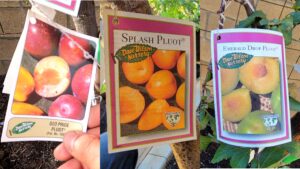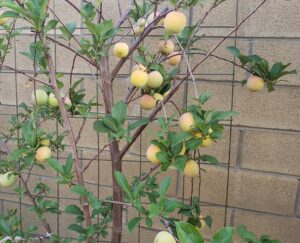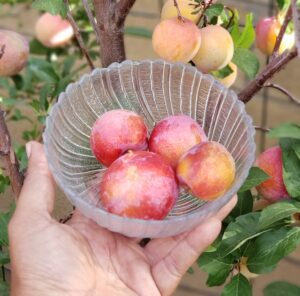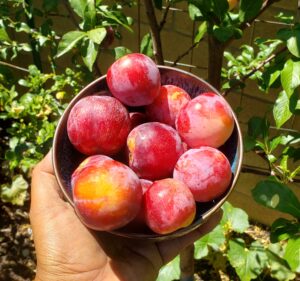Pluots are a combination of the flavors of the plum and apricot fruits, and one of the most delicious fruits you can grow in your backyard. In this blog, we go over all the aspects of growing pluots in your garden, caring for your pluot tree, and all the way up to harvest.

PLANTING
The only way to start pluots is to get a pluot tree from your local nursery. We used a multi-grafted pluot tree, so it has multiple flavors of pluots growing on one tree. This will not only help with the pollination and fruit setting for this tree, but it is also very satisfying to grow different tasting fruits in the same family on one root stock. We used a semi-dwarf tree that only reaches to about ten feet or so in height, which gives you a very beautiful looking tree with easy-to-harvest fruits. The varieties on the tree included the Geo Pride pluot, Splash pluot, and Emerald Drop pluot. Each one has different chill hours to provide the best benefit of growing these varieties.

Planting time for pluots is December through March, and this is when they start showing up at your local garden stores and nurseries. We started growing ours in March, and lots of flowers emerged from all the grafts. Pluots need some chill hours to produce fruit, which means it needs a temperature between 35 and 45 degrees Fahrenheit. Some of the varieties on this multi-grafted tree may not produce fruits because of their required chill hours, but they will at least pollinate the other varieties on the tree.
Choose a nice sunny spot for your pluot plant. This being a semi-dwarf tree, won’t require a large growing space, but this at least requires a 3ftx3ft space.
FERTILIZER
You can use salt-based fruit tree fertilizer for faster results, or you could use a granular organic fruit tree fertilizer. Pluots need consistent fertilizer, but they also need a mix of manure and compost. Planting mix at your local garden store will likely include what is needed for your soil. It adds organic matter and improves the beneficial bacteria in your soil. Once your soil is placed, you can place your fertilizer on top and mix it into the soil really well. This fertilizer schedule must be carried out every few months. Once done, water the plant thoroughly, which many people don’t do.
WATERING
Pluots are drought-resistant plants, but they need plenty of water in their growing stage. We set our dripper to drip one gallon per hour for thirty minutes, once every seven days in the summer and once every fifteen days in the winter. I also hand-water once in a while if it’s too hot. Do not water your fruit trees every day, as that will cause root rot. When your fruits are maturing and concentrating the sugar during July and August, you can cut down on the water just a little bit. Make sure to water just enough (but not too much) to keep your plant happy.

HARVESTING
By June, the fruits will have a nice orange-red blush on them, which indicates that they are ripening. Although it may be tempting to harvest them now, you must wait until they take on a darker orange or red color. It also depends on the variety you grow, as the pluot may even take on a yellow color when it is fully ripe.

July is when you can begin harvesting your pluots. The ripe pluots will give in just a little when you gently press on them, so if they’re too hard, leave them to ripen. At this stage in July, the pluots are only about 80% ripe and sweet. You can still harvest a couple to taste, but we recommend waiting until August to begin harvesting for even sweeter fruits.
In August, our pluots turned into a reddish-blue color, and they are very ripe. You can start harvesting the softest fruits. These ripe pluots will stay on the plant for a few weeks. Pluots are not as tart as a plum, nor are they as soft as an apricot. They are very sweet and delicious, as they include the flavors of plums and apricots. You cannot buy these fruits at your local grocery store, which is a compelling reason to grow this fruit in your backyard.

PEST PROBLEMS
While I did not see any insects or diseases on my pluots while they were growing, you might experience issues with squirrels eating your ripe fruits. In that case, use protective netting to protect your fruits against outside forces.
Watch the full video at How To Grow Pluots – A Delicious Plum / Apricot Fruit 3-In-one Pluot – Easy To Grow In Your Garden!

0 Comments